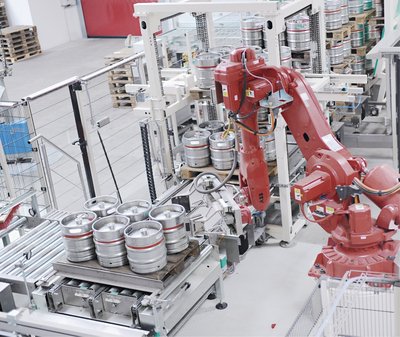Red robots in the red house
Germany’s Black Forest has long been famous for its natural beauty, clean water and clean air. It also has a tradition of precision workmanship going back many centuries, with products such as its clocks being famous the world over. The Rothaus brewery, maker of the famous Tannenzäpfle beer, uses four ABB robots in handling and packaging.
High up in the Black Forest in south-west Germany sits the 221-year-old Rothaus (‘red house’) brewery. The beer brewed there has long since achieved a cult status among German beer drinkers, and the brewery’s distinctive beer bottles, with their foil cladding and label showing a German Fräulein, are known throughout Germany, and beyond.
The Rothaus State Brewery was founded in 1791 by monks from the nearby St Blasien monastery. Enough spring water and wood was available near the red house, above the picturesque village of Grafenhausen, to adequately supply the water- and energy-intensive beer operation. After the monastery was dissolved, ownership passed to the Grand Duchy of Baden in 1806. Later, it was taken over by the state, in whose ownership it remains. The famous stylised Fräulein figure, essentially unchanged since the 1960s, has been dubbed Birgit Kraft, from the local pronunciation of “Bier gibt Kraft” (beer gives you strength).
With an annual production of 840,000 hectolitres, the Badische Staatsbrauerei Rothaus AG is now one of the biggest in the Baden-Württemberg region. Despite being over two centuries old, the brewery is nowadays equipped with the latest in modern technology, including four ABB robots that handle the beer kegs and cases.

On the production floor, an ABB robot can be seen bending gracefully forward and gripping a stainless steel beer keg gently but firmly around its mid-section, then smoothly rotating 90° and carefully placing it, inverted, in the packing area. For many years, keg handling was done by hand; then, later, by an elaborate gantry unit. Now, two identical ABB IRB 6640 robots perform the task, like clockwork and with much less fuss. The special Foundry Plus 2 robot variant is suited to conditions in the brewery. One jockeys the empty, not yet cleaned, stainless steel kegs from a wooden palette onto a conveyor belt. A good 10 minutes later, its partner neatly stacks the now thoroughly cleaned and filled kegs. The two robots are painted the fiery Rothaus RAL 3000 red, like all other moving equipment in the brewery.
“They couldn’t be more reliable and low-maintenance,” reports Robert Jäger, who is in charge of the beer-filling operation, “and in comparison to the earlier gantry unit they take up a lot less room, too.”
The IRB 6640 comes in different arm lengths and handling capacities. The robot can bend backwards fully, providing a large working range while permitting it to fit into space-restricted production lines. Typical application areas are materials handling, machine tending and spot welding. The robot is also available with different options for different working environments, such as Foundry Plus 2, Foundry Prime 2 and Clean Room. The maximum payload is 235kg, which makes the robot suitable for many heavy materials handling applications such as those at the Rothaus brewery.
IRB 6640 runs the second generation of TrueMove and QuickMove from ABB. This gives the robot highly accurate motion, which translates into less time for programming as well as a better process result. This software also supervises internal robot loads, meaning reduced risk of overload and longer robot lifetime.
However, only 10% of the Rothaus beer ends up in kegs; the rest goes into the attractive bottles so loved by beer drinkers up and down the country. Of the bottled beer, one in every eight is sold in a six-pack - and here again, an ABB robot has a hand in passing around the beer. Since 2005, an IRB 6640 robot has been assisting the automated packing machine in which a 24-bottle crate is repacked into four six-packs. The IRB 6640’s strong beer-lifting arm can effortlessly move its 142 kg load onto a conveyor belt.
The beer crates come tied together, for safety during transport, in a four-crate-wide, two-crate-deep configuration. Removing the safety band is the job of the fourth member of the ABB robot team: the small IRB 140. Despite its rather diminutive size compared with its colleagues, it is very capable nonetheless.
Project leader Ralf Krieger is also pleased with the ABB products, saying “Like the two robots in the filling area, these two were also brought into service really quickly.” These are words that the ABB team members like to hear - maybe they will celebrate them by clinking together some of those attractive foil-topped bottles.
Egg producer improves efficiency with flexible marking system
A Spanish poultry company needed an operator-friendly and reliable marking system to mark 200,000...
Women in automation: Ella Shakeri
On International Women's Day 2024, Swisslog System Design Engineer Ella Shakeri is...
Keeping manufacturing and distribution on track
RFID systems can help revolutionise the way a business tracks goods and manages inventory.








